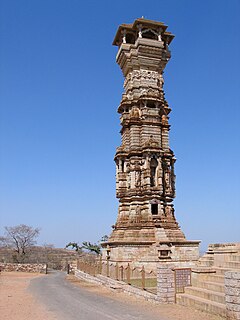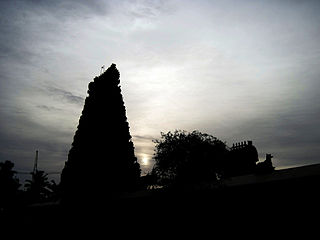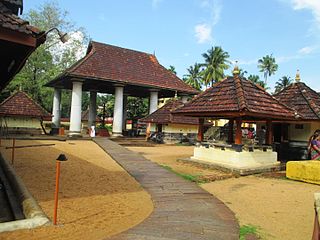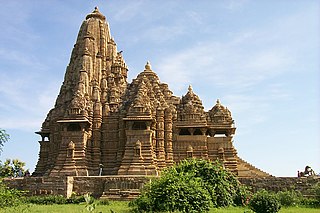
Puja or Pooja (IAST: pūjā; Devanagari: पूजा; IPA: [puːd͡ʒɑː]; is a prayer ritual performed by Hindus of devotional worship to one or more deities, or to host and honor a guest, or one to spiritually celebrate an event. It may honour or celebrate the presence of special guest, or their memories after they die. The word "pūjā" is Sanskrit, and means reverence, honour, homage, adoration, and worship. Puja, the loving offering of light, flowers, and water or food to the divine, is the essential ritual of Hinduism. For the worshipper, the divine is visible in the image, and the divinity sees the worshipper. The interaction between human and deity, between human and guru, is called darshan, seeing..

Stambha - is used to denote pillar or column. In the context of Jain & Hindu mythology, it is believed to be a cosmic column which functions as a bond, which joins the heaven (Svarga) and the earth (Prithvi). A number of Hindu scriptures, including the Atharva Veda, have references to Stambha. In the Atharva Veda, a celestial stambha has been described as an infinite scaffold, which supports the cosmos and material creation.

Jobner is a town and a municipality in Jaipur district in the Indian state of Rajasthan.

Birla Mandir is a Hindu temple, built on a 280 feet (85 m) high hillock called Naubath Pahad on a 13 acres (53,000 m2) plot. The construction took 10 years and was opened in 1976 by Swami Ranganathananda of Ramakrishna Mission. The temple was constructed by Birla Foundation, which has also constructed several similar temples across India, all of which are known as Birla Mandir.

Dhvaja, meaning banner or flag, is composed of the Ashtamangala, the "eight auspicious symbols."

The Kodikkunnu Bhagavathy Temple or Kodikkunnu Ambalam is a famous Hindu temple dedicated to Goddess Durga located in the village of Pallippuram, near Pattambi, in Palakkad district of Kerala, India. The goddess is commonly referred to as the Bhagavathy or Kodikkunnathamma.

Kodi Parakuthu is a 1988 Tamil language action film, directed by P. Bharathiraja. The film starred Rajinikanth, who worked with Bharathiraja nearly a decade after their last film 16 Vayathinile (1977). The film got mixed reviews and was a below average grosser at the box office.

Thirumullaivoyal is a fast developing residential neighbourhood in Chennai Metropolitan Area in India. It is part of west Chennai, 2 km (1.2 mi) from Ambattur. With its close proximity to Ambattur on its south-east and Avadi to its south-west, it has become a popular residential neighbourhood. The neighbourhood is served by Thirumullaivoyal railway station & Annanur Railway Station.
Kodi Ramakrishna was an Indian film director and writer known for his works predominantly in Telugu cinema, and a few Tamil, Malayalam and Hindi films. One of the prolific film director in Telugu, Kodi Ramakrishna has directed a wide range of films, in a variety of genres such as drama films; Intlo Ramayya Veedilo Krishnayya (1982), Mangamma Gari Manavadu (1984), Thalambralu (1986), Aahuthi (1987), Bharatamlo Bala Chandrudu (1988), Station Master (1988), Muddula Mavayya (1989), Maa Aavida Collector (1996), Pelli (1997), and Dongaata (1997).
Hindu architecture is a traditional Hindu system of temple architecture, monasteries, mausoleums and other architectural religious buildings of Hinduism. The science of Hindu architecture in India is described in Hindu texts — Vastu shastra, and Shilpa Shastras deal with forming statues, icons, stone murals, painting and others. Due to Islamic conquests in the Middle Ages, many ancient Hindu buildings were destroyed.
The Narainsamy Temple is a provincial heritage site in Inanda in the KwaZulu-Natal province of South Africa.

ThiruvanchikulamSivaTemple is a Hindu temple situated in Kodungallur in Thrissur district in the South Indian state of Kerala in India. Constructed in the Kerala style of architecture, the temple is believed to have been built during the Chera period in the 8th century. Shiva is worshipped as Mahadeva and his consort Parvathi as Umadevi.
There are places of worship considered important in the Kannur district. Kannur District is one of the 14 districts in the state of Kerala, India. The town of Kannur is the district headquarters, and gives the district its name.
Sri Prasanna Venkata Narasimha Perumal is a Hindu temple in Saidapet, Chennai, in the Indian state of Tamil Nadu. It is dedicated to Venkateswara, an incarnation of the Hindu deity Vishnu. It was constructed during the 15th century, but, according to historical records and inscriptions found within the temple, may consist of elements dating back more than 1000 years. The temple was constructed during the era when the South India was under the rule of the Vijayanagara Empire.

Mumba Devi Mandir is an old temple in the city of Mumbai, Maharashtra dedicated to the goddess Mumbā, the local incarnation of the Devi. Marathi Mumbā derives from Sanskrit While Hindu sects devoted to the goddess Mumbadevi are attested to as far back as the 15th century, it is said that the temple was built in 1675 near the main landing site of the former Bori Bunder creek against the north wall of the English Fort Saint George by a Hindu woman also named Mumba. The creek and fort are now deteriorated to a point at which they are but derelict reminders of the city's past. The temple, on the other hand, is still active.

Tiru Pavala Vannam or Pavalavanam temple located in Kanchipuram in the South Indian state of Tamil Nadu, is dedicated to the Hindu god Vishnu. Constructed in the Dravidian style of architecture, the temple is glorified in the Divya Prabandha, the early medieval Tamil canon of the Azhwar saints from the 6th–9th centuries AD. It is one of the 108 Divyadesam dedicated to Vishnu, who is worshipped as Pavalavannar Perumal and his consort Lakshmi as Pavazhavalli.

Neengalum Vellalam Oru Kodi, also known by the acronym NVOK, is an Indian Tamil language game show. It is the official Indian Tamil adaptation of the game show Who Wants to Be a Millionaire? and its successful Hindi version Kaun Banega Crorepati.
Kodi Amman Temple is a Hindu temple situated at Sungan Thidal, 2 kilometres from the town of Thanjavur on the Thanjavur-Kumbakonam road.

Kailasanathar Temple in Srivaikuntam, a village in Thoothukudi district in the South Indian state of Tamil Nadu, is dedicated to the Hindu god Shiva. It is located 30 km from Tirunelveli. Constructed in the Dravidian style of architecture, the temple has three precincts. Shiva is worshipped as Kailasanathar and his consort Parvati as Sivakami. The temple is the sixth temple in the series of Nava Kailasams where the presiding deity of all the nine temples is Kailasanathar and associated with a planetary deity. The temple is associated with the planet Saturn.

Kodi is a 2016 Indian Tamil-language political action thriller film written and directed by R. S. Durai Senthilkumar and produced by Vetrimaaran under his banner Grass Root Film Company. The film stars Dhanush, Trisha Krishnan and Anupama Parameswaran along with S. A. Chandrasekhar and Saranya Ponvannan. Dhanush, who produced R. S. Durai Senthilkumar's previous two films, Ethir Neechal and Kakki Sattai, played dual roles for the first time. The film's music and background score were composed by Santhosh Narayanan, the cinematography is performed by Venkatesh S. The film was simultaneously dubbed in Telugu as Dharmayogi, which released one day after the Tamil version. Upon release the film opened to positive reviews from critics praising Dhanush's performance. The film was remade in Kannada as Dhwaja in 2018.

















